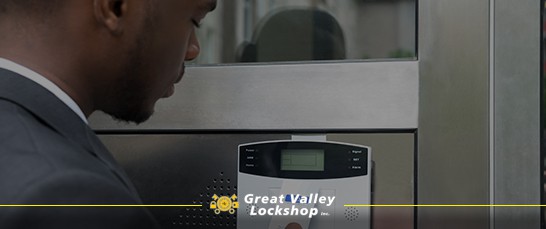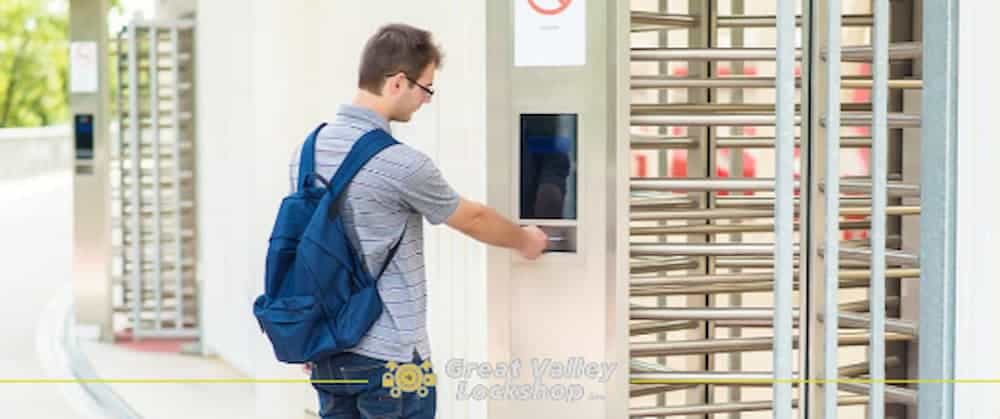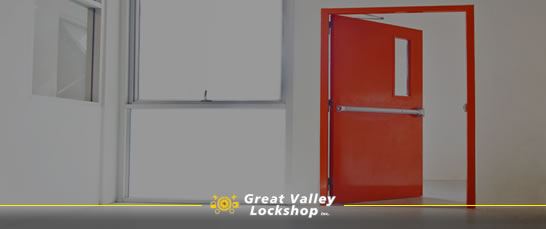
Getting Started with Commercial Access Control Systems
If your company has invested in an access control system, then you want to be sure you’re getting the best value out of it. When it comes to commercial security, these advanced systems provide significant advantages.
In this overview, we answer the following questions:
- What is an access control system?
- What types of entry credentials can systems utilize?
- Which types of buildings can benefit from access control?
- What are the advantages of commercial access control?
- How can you select the right system for your building?
- How can an access control system be used more effectively?
What Are Access Control Systems?
Access control relies on a unified management platform connected to multiple locks and proximity devices for streamlined security. The unified management platform provides real-time information about who is entering which locations and when and can be programmed remotely. Doors are locked automatically and allow entry for individuals using a range of devices – from simple proximity or keypad-controlled door locks to access card readers and advanced biometric scanners.
The goal of access control is to provide organizations with an additional layer of security by managing user permissions at entry points and entry time frames. For example, companies can block entry during non-business hours. Business facilities can also permit visitors and staff to access main entrances, while restricting access to certain areas that require special authorization. Generally, they are a great way to boost commercial security and increase accountability.
Access Control Credentials
Commercial access control systems can be designed to work with different types of credentials.
Biometric
Biometric entry utilizes specific physical data to verify users and grant entry permission. These devices typically rely on a fingerprint scanner. Retina scans and facial recognition devices are also being used with more frequency.
Access Cards & Key Fobs
Contactless cards and key fobs are small devices that are set up to “pair” with proximity devices. When they are used as a “key”, they are programmed with a unique code for each user.
Keypads
Keypads tend to be less expensive than other options. They require users to manually insert their individual identification codes in order to unlock a door and gain access to certain areas of the building.
Applications
Access control is ideal for commercial buildings, offices, manufacturing facilities, residential structures, hospitals, and college campuses.
Advantages of Access Control for Commercial Buildings
This type of commercial security solution requires a significant investment; why should my company consider it?
Better Security
Electronic access control originated as a concept to improve security measures. Unlike traditional keys that can be easily copied, the proximity cards, entry codes, and biometric input that are used to gain access are unique and traceable to individual users.
Access control provides instant oversight of what is happening at your business’s entry points. Each time someone enters using an electronic access key, its use is logged in the system. This feature enables your organization to effectively investigate criminal activity like theft, trespassing, and vandalism.
Business owners or managers use an access control system to limit entry points to only authorized personnel during set hours in order to tighten security in restricted areas. They can also use it to eliminate one’s access permanently in cases of termination without the need to reissue cards for the entire staff. If an access card is lost or misplaced, that particular key code can be blocked, and then new access permissions can be granted. There’s no more need to rekey the building or change all the locks.
Find out how to Increase Security at Your Commercial Building.
Convenience
For users, there’s no more need to fumble with bulky key rings. You can provide certain staff with the access they need within the building by simply updating the permissions associated with their key card or entry code. One quick swipe lets them get around easily.
For managers, these systems make it simple to manage permissions and even grant access remotely. They can unlock the door for a weekend or after-hours delivery without even being in the building.
Efficient Employee Payroll
One way to save money and valuable time is to use an access control system that synchs with payroll programs. Access data eliminates the need for manual data entry of timecards. This means greater accuracy and fewer problems with delinquency. Access systems automatically log when employees arrive and leave the workplace, even for lunch breaks. This equates to less time spent processing employee payroll and encourages staff punctuality.
Flexibility
Access control systems are custom designed and installed to fit your business. They are flexible solutions. Access permissions for individual users, times and days when entry is restricted, and settings for certain doors and entry points can be programmed to meet the specific needs of your business.
Lower Utility Consumption
Advanced access systems work together are automated to support energy savings. They can be programmed to automatically turn off lights and turn down the heating or air conditioning in any rooms or areas when they are unoccupied.
Watch this video to see how one access control brand makes it easy for employees to manage permissions using a specialized mobile app.
How to Choose the Right Access Control for Commercial Buildings
If your company is looking into purchasing a new access control system or updating to a newer system, there are a lot of factors that should be considered. To help make this decision easier, we have put together a list of the main questions that you should ask when selecting a system.
1. Will My Company Be Able to Manage the Access Control System Easily?
The first factor to consider when choosing the right commercial access control system is whether your business will have problems using and implementing it. It doesn’t make sense to invest in a system that will be used incorrectly or not at all because it doesn’t fit the company’s needs.
Owners and managers should decide ahead of time who will manage the system and what the operational access policies will be put into place. These should cover the protocol for onboarding new hires and deactivating access privileges for employees leaving the company. Be realistic about the amount of time needed to handle this job and enforce policies.
2. What Functions & Integrations Will Your Company Require?
Secondly, you should define the ideal functions to fit your business. Think about the need for an on-site, web-based, or remote access control interface. Discuss which access points and areas of the facility require a higher level of security. Make a list of the options and integrated systems that will help your business boost security. These may include:
- Access reporting,
- Remote monitoring via a mobile app or computer,
- Real-time notifications,
- Surveillance or CCTV cameras,
- Emergency exit notifications,
- Integration with HR management programs,
- Fire detection and alarms, and
- Break-in detection and security alarms.
Additional features may include integrated cashless vending, staff time monitoring and attendance tracking.
3. How Much Traffic Will the Access Control System Handle?
Finding the right type of access control system depends heavily on the robustness required. This takes into account the number of employees and staff who will need entry permission, as well as the amount of traffic that will need to be managed at any one time. Depending on the structure of your company, you may also need to consider access for deliveries and visitors.
Think about the flow of people coming in and out of the building during office hours, the evening and weekend. Access systems should fit the number of entry points in the building while unifying entry data, time stamps, users, credentials, and permissions in one portal.
4. Which Entry Method Will Work Best for Your Business?
There are a lot of options to consider in terms of entry input methods. Proximity readers that operate with access cards or fobs, keypads and biometric entry systems offer different levels of security and speed of use. For example, biometric systems are considered more secure because entry input cannot be shared with other users. However, because they tend to slow down entry traffic, biometric systems aren’t the best solution for buildings used by a large number of employees or staff.
5. How Scalable Is the Access Control System?
It’s true that access control systems can be selected to fit smaller or larger facilities with different needs in terms of traffic. But your company should consider future growth. If you foresee an increase in the number of employees or the size of the facility in the coming years, the access system should be flexible enough to accommodate this growth. When considering scalability, think about the business outlook for the next 5 – 10 years.
6. How Does the System Function in Emergency Situations?
Access control systems generally work with electrified automatic hardware or electromagnetic locks. The type of business and the relevant building codes and fire safety regulations will help determine what kind of hardware is needed. Fail-safe hardware will unlock in case of a power outage or emergency, allowing easy egress. Alternately, fail-secure hardware stays locked from the outside if electricity fails for any reason. When selecting an access system, it’s important that it works with the existing hardware and meet all building and safety standards.
7. Can the Access System Be Easily Upgraded and Serviced?
For the long-term company budget and facility security standards, ask about when upgrades and component replacement will be necessary. A controlled access system must grow and evolve with your business’ needs. As the technology available for access control improves, your company will also want to keep the system up to date to ensure top security. Our locksmiths advise clients to consider upgrades every three to five years.
Systems must stand up to a lot of wear and tear over the years, especially or high-traffic usage. When looking at the various commercial access control systems available, your company should also consider the length of the warranty or service period offered by the manufacturer and installer.
Tips for Improving the Effectiveness of an Access Control System
Each building is different, and every company has different security needs. An access control system is a flexible solution that is most effective when selected to fit a specific environment. We recommend periodically evaluating the security challenges in your office or facility and checking that the system addresses those. Changing the program settings also might be a quick fix for the situation.
Specifically, ask your staff if:
- Does it control access to all of the high-security areas?
- Is effective during the times of day when security is the biggest concern?
- How many people are using the access control system? Does it work efficiently for that level of traffic?
- Does it work well with any other security system or security measures used on the property?
Verify if the Technology is Outdated.
As technology improves, it’s likely that newer features and settings could more accurately meet those challenges. Sometimes an update, upgrade, or switch to a different brand of access system can make a noticeable difference.
Our professional locksmiths recommend that business plan for technology updates. Dedicate a portion of the annual budget for maintenance, but also budget for upgrading in the long-term. An access control system will likely need to be replaced every 8 to 10 years.
Make Sure the Access Control System is Set Up Properly.
Access control systems are most effective when they are programmed to fit a building’s security demands. Settings need to allow and restrict access at exterior entry points during specific times of day and on certain days of the week. Facility managers and supervisors should give careful consideration from the beginning about where access is more strictly controlled and which users are permitted entry into each building or department.
Test Performance & Maintain the System.
Just like anything we rely on for security, regular testing and maintenance are important steps. Make sure that testing procedures and maintenance checks are part of the annual calendar for your facility.
Establish a Protocol for Traffic Data Use.
Management should set up a process for how and when information about traffic will be used. Whether it’s reviewed daily to track employee work hours, regularly to see the average flow of people coming into the building, or as needed for security issues, these details should be defined. This applies to the main door as well as specific high-security points.
Implement Access Levels.
One of the great advantages of access control is that the system can be customized to an individual building. Consider each section of the building and its particular security needs. Access should only be granted to users who need to use that space.
Review the entry credentials for each point and check if they should be more restricted. Be sure that access has been canceled for employees who have left the company or have been fired. Then, go through and update the list of users and their level of access.
Third-party service providers should have strictly controlled access levels according to the areas that need to be accessed. Additionally, it’s important to restrict access in terms of work hours and period of time.
Keep Access Devices Updated.
Whether your company uses keypads, key fobs, access cards or biometric input, access device permissions should be regularly updated.
- Access devices should be collected as each visitor exits.
- Access devices should be collected and permissions deactivated when staff leaves the company.
- Each code, fob, card or fingerprint should allow entry only for a set period of time.
- After six months or one year, the system should automatically block access and require renewal for continued use.
- The automatic block should occur sooner (about every two to three months) for third-party users.
These guidelines should help force your business to review user access permissions regularly and keep everything as up to date as possible.
Inform Staff About Correct Use.
New employees and staff should be informed about your company’s expectations when it comes to access control. Provide clear policies and training for all current employees and new hires. For example, they should know that holding the door open for others or allowing people to tailgate into the building is unacceptable.
Double Up on Security.
Finally, consider using a double-check procedure in which supervisors must sign off on each entry request. This practice can decrease entry abuse and tailgating.
The record created can be stored electronically for future reference. For example, access validation is helpful in case valuable equipment or materials go missing, damaged, or stolen.
Learn more about Cloud-Based Access Control.
Commercial Security Solutions
For more information about commercial access systems and controlled entry management, contact the professional locksmiths at Great Valley Lockshop. You can reach us at 610-644-5334 or request a quote here.








